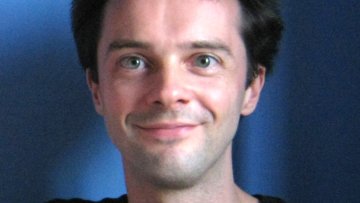Wave attenuation by flexible vegetation
Abstract
Coastal vegetation has a well-known effect of attenuating waves; however, quantifiable measures of attenuation for general wave and vegetation scenarios are not well known. On the plant scale, there are extensive studies in predicting the dynamics of a single plant in an oscillatory flow. On the coastal scale however, there are yet to be compact models which capture the dynamics of both the flow and vegetation, when the latter exists in the form of a dense canopy along the bed. In this talk, we will discuss the open questions in the field and the modelling approaches involved. In particular, we investigate how micro-scale effects can be homogenised in space and how periodic motions can be averaged in time.
Mathematrix - Meet Prof Andrew Hodges
Abstract
Author of Alan Turing: The Enigma, sharing his academic path and experience as activist for LGBTQ+ rights
Graham Farmelo - The Universe Speaks in Numbers
The supreme task of the physicist, Einstein believed, was to understand the 'miraculous' underlying order of the universe, in terms of the most basic laws of nature, written in mathematical language. Most physicists believe that it's best to seek these laws by trying to understand surprising new experimental findings. Einstein and his peer Paul Dirac disagreed and controversially argued that new laws are best sought by developing the underlying mathematics.
Graham will describe how this mathematical approach has led to insights into both fundamental physics and advanced mathematics, which appear to be inextricably intertwined. Some physicists and mathematicians believe they are working towards a giant mathematical structure that encompasses all the fundamental laws of nature. But might this be an illusion? Might mathematics be leading physics astray?
Graham Farmelo is a Fellow at Churchill College, Cambridge and the author of 'The Strangest Man,' a biography of Paul Dirac.
5.00pm-6.00pm
Mathematical Institute
Oxford
Please email @email to register.
Or watch live:
https://www.facebook.com/OxfordMathematics/
https://livestream.com/oxuni/farmelo
The Oxford Mathematics Public Lectures are generously supported by XTX Markets.
A Beautiful Game from the War: Piet Hein, John Nash, Martin Gardner and Hex
Abstract
Seeking income during World War II, Piet Hein created the game now called Hex, marketing it through the Danish newspaper Politiken. The game was popular but disappeared in 1943 when Hein fled Denmark.
The game re-appeared in 1948 when John Nash introduced it to Princeton's game theory group, and became popular again in 1957 after Martin Gardner's column --- "Concerning the game of Hex, which may be played on the tiles of the bathroom floor" --- appeared in Scientific American.
I will survey the early history of Hex, highlighting the war's influence on Hein's design and marketing, Hein's mysterious puzzle-maker, and Nash's fascination with Hex's theoretical properties.
15:00
Cluster Adjacency
Abstract
Cluster Adjacency is a geometric principle which defines a subclass of multiple polylogarithms with analytic properties compatible with that of scattering amplitudes and Feynman loop integrals. We use this principle to a priori remove the redundances in the perturbative bootstrap approach and efficiently compute the four-loop NMHV heptagon. Moreover, cluster adjacency is naturally applied to the space of $A_n$ polylogarithms and generates numerous structures therein to be explored further.
12:00
The fishnet model: an integrable scalar CFT in four dimensions
Abstract
I will review the fishnet model, which is an integrable scalar QFT, obtained by an extreme gamma deformation of N=4 super Yang-Mills. The theory has a peculiar perturbative expansion in which many quantities at a fixed loop order are given by a single Feynman diagram. This feature allows the reinterpretation of Feynman loop integrals as integrable systems.
For the first time, on February 14th at 10am Oxford Mathematics will be LIVE STREAMING a 1st Year undergraduate lecture. In addition we will film (not live) a real tutorial based on that lecture.
After the huge success of making an undergraduate lecture widely available via social media last term, we know there is an appetite to better understand Oxford teaching. In turn we want to demystify what we do, showing that it is both familiar but also distinctive.
16:00
"Large continua via ultracoproducts"
Abstract
It is known that every continuum X is a weakly confluent image of a continuum Y which is hereditarily indecomposable and of covering dimension one. We use the ultracoproduct construction to gain information about the number of composants of Y. For example, in ZFC, we can ensure that this number is arbitrarily large. And if we assume the GCH, we can arrange for Y to have as many composants at it has points.
16:00
‘Expansivity and shadowing’
Abstract
Abstract: Let $f$ be a continuous surjection from the compact metric space $X$ to itself.
We say that the dynamical system $(X,f)$ has shadowing if for every $\epsilon>0$ there is a $\delta>0$ such that every $\delta$-pseudo orbit is $\epsilon$-shadowed. Here a sequence $(x_n)$ is a $\delta$-pseudo orbit provided the distance from $f(x_n)$ to $x_{n+1}$ is less than $\delta$ and $(x_n)$ is $\epsilon$-shadowed if there is a point $z$ such that the distance from $x_n$ to $f^n(z)$ is less than $\epsilon$.
If $f$ is a homeomorphism, $(X,f)$ is said to be expansive if there is some $c>0$, such that if the distance from $f^n(x)$ and $f^n(y)$ is less than $c$ for all $n\in \mathbb Z$, then $x=y$.
In his proof that a homeomorphism that is expansive and has shadowing is stable, Walters shows that in an expansive system with shadowing, a pseudo orbit is shadowed by exactly one point. It turns out that the converse is also true: if the system has unique shadowing (in the above sense), then it is expansive.
In this talk, which is joint work with Joel Mitchell and Joe Thomas, we explore this notion of unique shadowing.


